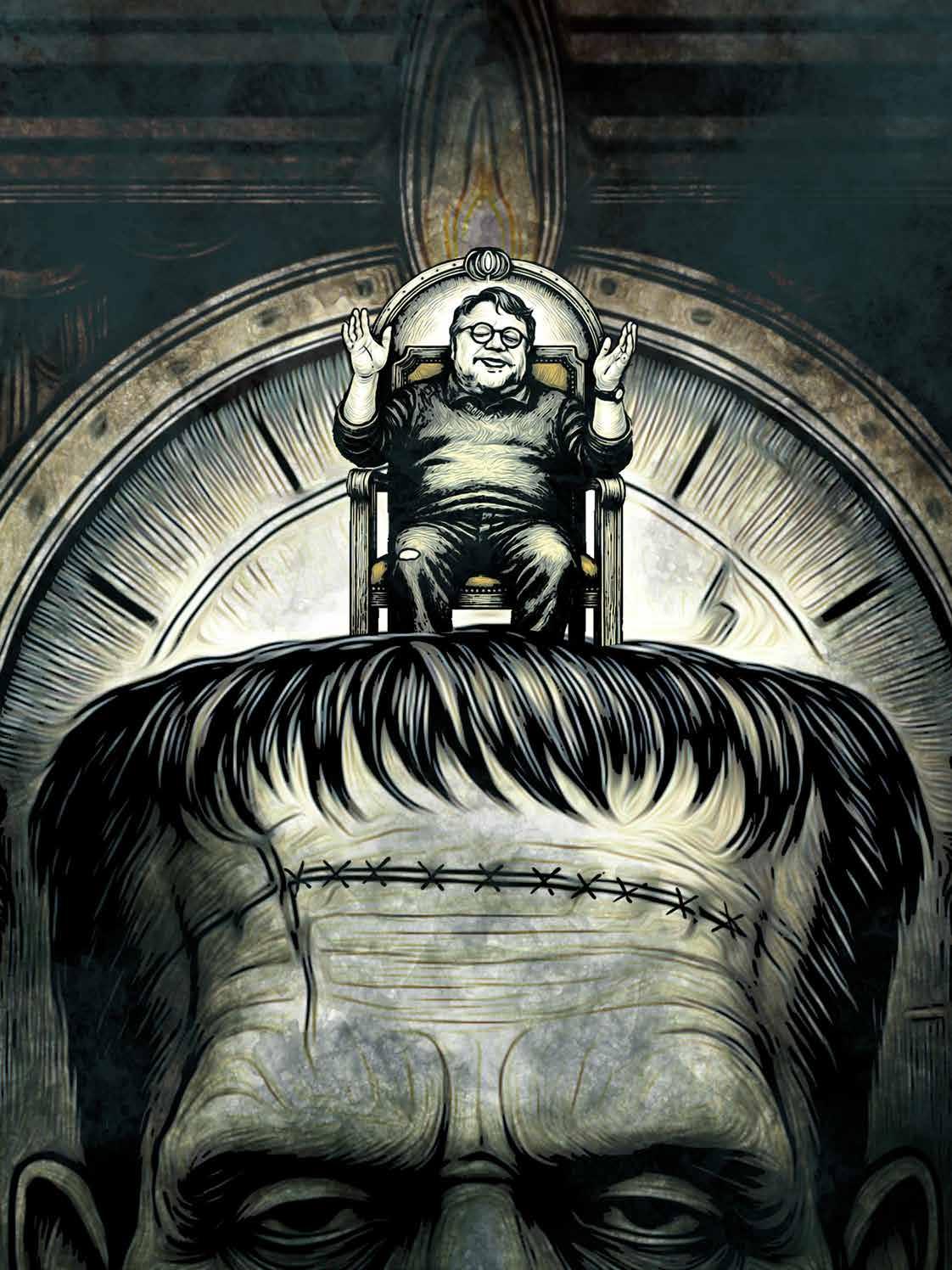

TO LIFE BRINGS Frankenstein del Toro Guillermo
THE FEARLESS MEXICAN USES HIS SPARK OF GENIUS AS A LIGHTNING BOLT OF CREATIVITY
ANGEL MIERES ZIMMERMANN CHAIRMAN OF
MARÍA CRISTINA MIERES ZIMMERMANN VICE PRESIDENT OF CULTURAL AND SOCIAL DEVELOPMENT
ANTONIO HOLGUIN ACOSTA VICE PRESIDENT OF INSTITUTIONAL RELATIONS
FRANCO CARREÑO OSORIO GENERAL DIRECTOR
ALFREDO GONZÁLEZ CASTRO EDITORIAL DIRECTOR
ALEJANDRA ICELA MARTÍNEZ RODRÍGUEZ COORDINATOR, HERALDO USA alejandra.martinezr @elheraldodemexico.com
ADRIÁN PALMA ARVIZU CREATIVE DIRECTOR adrian@elheraldodemexico.com
DANIEL ERNESTO BENET SÁNCHEZ NORIEGA EDITOR, HERALDO USA daniel.benet@elheraldodemexico.com
ALAN ARTURO VARGAS JUÁREZ EDITOR, HERALDO USA alan.vargas@elheraldodmexico.com
ISMAEL ESPINOZA SUÁREZ, OMAR MÁRQUEZ GRAJALES DESIGN
ALEJANDRO OYERVIDES INFOGRAPHICS

Periódico El Heraldo de México. Editor Responsable: Alfredo González Castro, Número de Certificado de Reserva otorgado por el Instituto Nacional del Derecho de Autor: 04-2009-060419022100-101. Número de Certificado de Licitud de Título y Contenido: 16921. Domicilio de la Publicación: Av. Insurgentes Sur, No. 1271, piso 2, oficina 202, Extremadura Insurgentes, Benito Juárez, C.P. 03740. Impreso en LA CRÓNICA DIARIA, SA DE CV, Avenida Azcapotzalco La Villa 160, Colonia San Marcos, Alcaldía Azcapotzalco, Ciudad de México, CP 02020. Distribuidores: ARREDONDO E HIJOS DISTRIBUIDORA, SA de CV, Iturbide 18 local D, Colonia Centro de la Ciudad de México Área 4, Alcaldía Cuauhtémoc, Ciudad de México, CP 06040. ELIZABETH IVONNE GUTIÉRREZ ORTIZ, Callejón 2o de la Luz 52, Departamento 4, Interior 1, Colonia Anáhuac II Sección, Alcaldía Miguel Hidalgo, Ciudad de México, CP 11320. AEROVÍAS EMPRESA DE CARGO, SA de CV, Paseo de la Reforma 445, Piso 9, Colonia Cuauhtémoc, alcaldía Cuauhtémoc, Ciudad de México, CP 06000 Publicación Diaria No. 3076, lunes 17 de noviembre de 2025. EL
MEXICO & CANADA
RESTORE TIES UNDER CARNEY’S ADMINISTRATION
Interview with Carlos Manuel Joaquín*
Mexico’s ambassador to Canada, Carlos Manuel Joaquín, describes the state of a quickly changing bilateral relationship—from the tensions that arose at the end of the Trudeau government to the renewed cooperation under Prime Minister Mark Carney. He highlights the growth of the Mexican community in Canada, the challenges caused by new visa rules, and the opportunities ahead in trade, tourism, and G7 collaboration.
BY:ALEJANDRA ICELA MARTÍNEZ
PHOTOART: IVAN BARRERA
ALEJANDRA ICELA MARTÍNEZ
(AIMR): How many Mexican men and women live there? How many go to work? How many are temporary workers? What do they do?
AMBASSADOR CARLOS MANUEL JOAQUÍN
(ECMJ): According to Canada’s census data, the official count is only about 90,000 to 100,000 Mexicans. However, our own estimates suggest there are around 250,000— possibly a bit more—living throughout this country. Many are temporary agricultural workers; others work in non-agricultural sectors under temporary labor programs. And of course, many are already permanent residents.
The rest are individuals who have residency or Canadian citizenship, including entrepreneurs, small and mid-sized business owners, restaurant owners, and people working across various provinces and cities in Canada.
There are also high-ranking Canadian government officials of Mexican descent, university researchers, leaders of organizations and business chambers, and even a
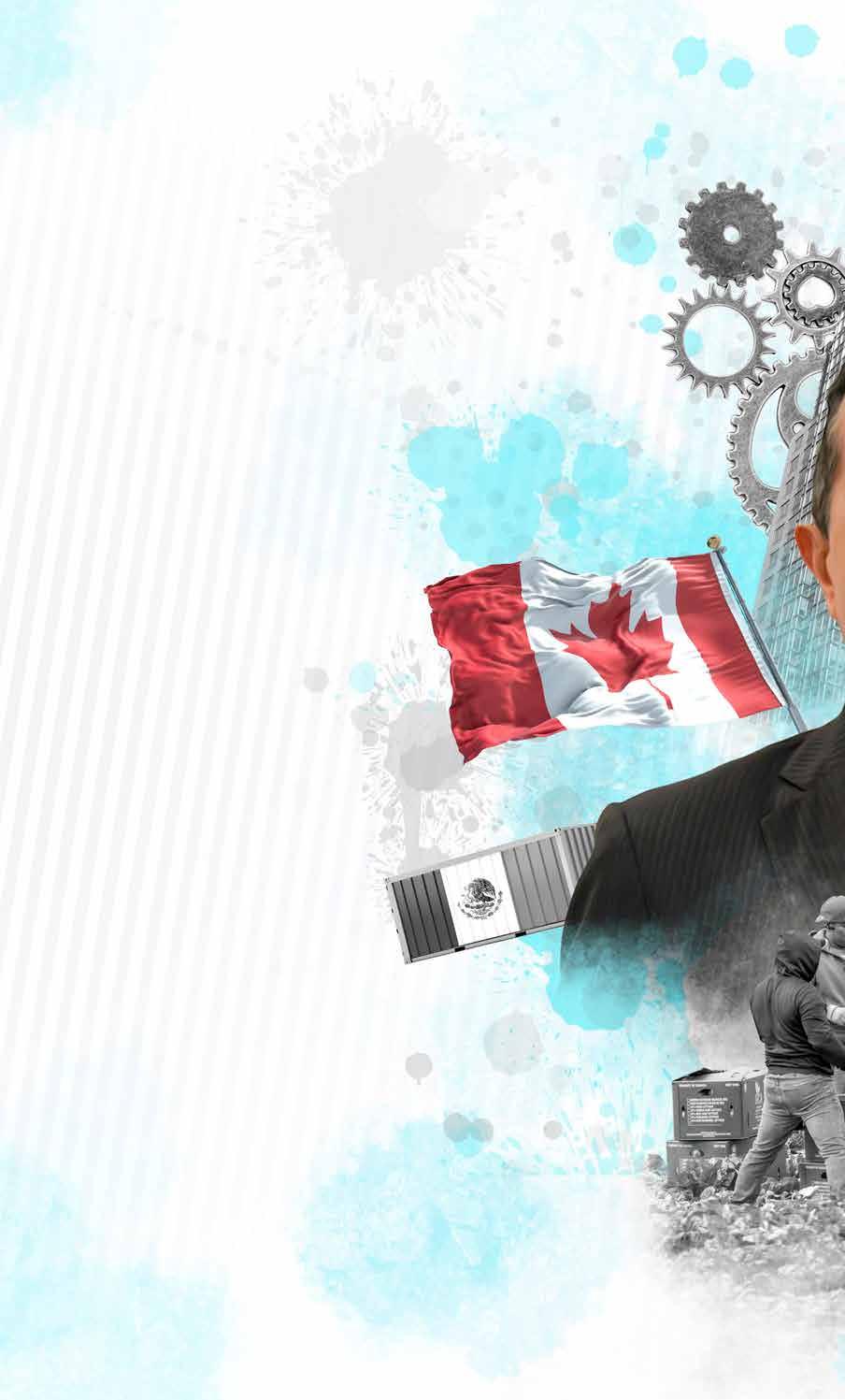
*Carlos Manuel Joaquín, Mexico’s Ambassador to Canada
parliamentarian whose mother is Mexican and father is Ukrainian—she was born in Canada. Like her, many others also live here.
AIMR: How has the relationship with the government been? It has changed over time. What was it like under Trudeau, and what is it like now under Prime Minister Carney?
ECMJ: Prime Minister Trudeau’s government initially enjoyed widespread popularity and support at the start of his term. Over time, that support began to decline within Canada’s administration.
Our relationship with him was always open and friendly, with important considerations for Mexico. Except toward the end of his term, when we started facing criticism from specific sectors of the Canadian government, initially from a provincial government, like a state government in Mexico. Ontario, home to Canada’s largest auto industry, viewed Mexico as a competitor—sometimes an ally, sometimes a rival.
MONDAY / 11 / 17 / 2025
They argued that Mexico should be excluded from the free-trade agreement, proposing a bilateral relationship between the United States and another country without Mexico, because they believed Mexico was receiving investment from China, which they claimed was harming Ontario’s auto sector. Later, the federal government under Trudeau echoed some of these claims. One of his ministers supported that stance. Those were complicated months—there wasn’t a direct rupture at the highest level, but at lower levels, communication became difficult. Still, Trudeau maintained dialogue with President Sheinbaum; they met at international events and spoke by phone.
AIMR: What activities took place during that difficult period?
ECMJ: We took several actions. We organized business events in Ottawa with U.S., Canadian, and Mexican business leaders to support the trilateral trade agreement and respond to the Canadian government’s statements.
This, of course, strained the bilateral relationship. A few weeks or months before Trudeau left office, we had direct talks with him and his senior staff. They apologized and acknowledged the need to rebuild the relationship. But the tension left a mark.
AIMR: What happened next with the incoming government?
ECMJ: The new Liberal government under Prime Minister Carney took power—something many thought unlikely. He recovered from nearly 20 points behind and succeeded in leading the Liberals back into government.
Our relationship with him and his cabinet has been very close and positive. They are fully committed to strengthening Mexico–Canada relations. Canada is seeking new markets, suppliers, and investors. They want to attract Mexican investment and increase Canadian investment in Mexico. They aim to expand trade.
Many efforts have already been undertaken to create new opportunities across diverse Canadian economic sectors.
AIMR: How has the Mexico–Canada relationship evolved since the new government took office? PM Carney has already visited Mexico and met with President Claudia Sheinbaum.
ECMJ: Canada currently faces significant challenges in its relationship with the United States, which, like Mexico, accounts for almost 80% of its international trade. As Canada works to diversify, Mexico becomes essential.
The Prime Minister’s recent visit aimed precisely at that goal. Two of his ministers had already traveled to Mexico before he arrived.
Today, Mexico’s Ministry of Economy has a close relationship with Canada’s Ministry of Economy and its Ministry of Economic Development, which oversees Canada–U.S. and Canada–Mexico trade. This has opened many opportunities.
For example, Canada invited President Sheinbaum to the G7 meeting, which she attended, and the Canadian government saw her participation very favorably. It offers a significant opportunity for Mexico to engage with the world’s leading economic powers.
AIMR: What has resulted from these meetings?
ECMJ: The follow-up G7 meetings are ongoing, and Mexico has been invited to participate. Mexico’s Environment Minister recently visited Canada, and additional visits from Canadian ministers to Mexico are scheduled.
02-03
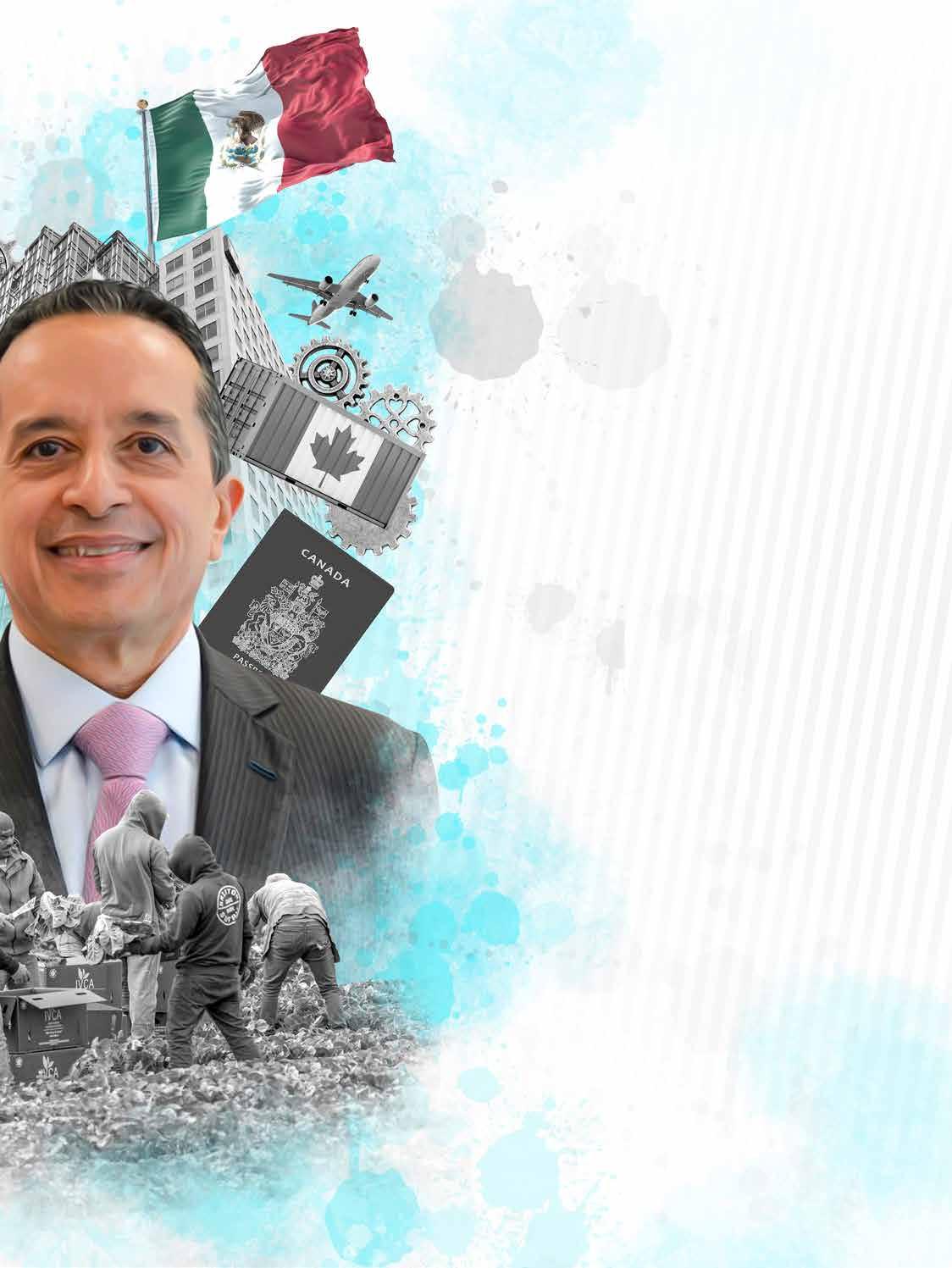
Canada’s Agriculture Minister has already met with Mexico’s Secretary of Agriculture.

More meetings are being scheduled on issues like security, border cooperation, and migration. Foreign Minister Juan Ramón de la Fuente will visit in a few days for a G7 follow-up event. The relationship is strong and is likely to grow even stronger in specific areas, such as investment and trade.
AIMR: Aside from political relations, in which areas have there been successes?
ECMJ: Tourism has been thriving. Many Canadians visit Mexico. Our popular destinations are very well known—especially Quintana Roo: Cancún, Riviera Maya, and Tulum. There are numerous direct flights from across Canada to Cancún and Tulum.
Puerto Vallarta, Nuevo Vallarta, and San Miguel de Allende are also popular destinations. Interest in Baja California Sur is growing, especially in Los Cabos. There is also increasing curiosity about Mexico’s UNESCO World Heritage cities and its Pueblos Mágicos.
AIMR: And what about Mexicans visiting Canada?
ECMJ: Travel from Mexico to Canada has decreased, mainly due to migration-related requirements.
Canada is expected to lose about 25% of Mexican visitors after reintroducing the visa requirement, which is an electronic permit linked to holding a U.S. visa. Recently, during a visit to the Quebec government, we were informed that Mexican visitors had decreased by about 30%. There are chances to improve the situation, especially with the upcoming World Cup.
AIMR: Speaking of sports, Alejandro Kirk, the Blue Jays’ catcher, has become a sensation…
ECMJ: He is highly respected here. People always congratulate us because of him. Unfortunately, the Blue Jays couldn’t win the championship, but Kirk has earned a very special place in Canadian society. They acknowledge his talent—and they proudly call him Mexican.
AIMR: What has been the biggest challenge you’ve faced in your role as an ambassador and representative of Mexicans in Canada?
ECMJ: Certainly, the moment when communication broke down between Mexico and Canada due to CUSMA/T-MEC and the Canadian government’s claim that they would seek a bilateral agreement with the U.S. without Mexico. That created central tension and required active diplomacy—demonstrating to them that the business sector did not support that idea, and preventing deeper fractures in the bilateral relationship.
Another major challenge was the sudden reintroduction of the visa requirement. It happened unexpectedly and during a sensitive time for Mexico, amid the election season. Naturally, this caused significant frustration within the Mexican government.
AIMR: What message would you send to Mexicans living in Canada who listen to us through Heraldo USA and Heraldo de México?
ECMJ: I send my warmest greetings to all of you. I know there are challenging moments, especially when government decisions make people vulnerable or expose them to discrimination. This is why it’s crucial to stay close to our consulates and the Mexican government— to make sure you can defend your rights, keep growing, and succeed in Canadian or U.S. society while staying connected to your family in Mexico.
We are here to serve you and support you.
Economist Mark Carney took over Canada’s leadership after Justin Trudeau’s resignation, pledging firmness toward the United States and a return to economic stability. His arrival marks a turning point in both Canada’s politics and its bilateral relations.
BY: LUIS PÉREZ COURTADE ART: ARTURO RAMÍREZ
The early elections of April 2025 in Canada brought victory to the Liberal Party under the leadership of Mark Carney, who took office following the resignation of Justin Trudeau, whose popularity had plummeted amid a cost-of-living crisis and criticism of his government’s immigration policies.
Carney, 59, a technocrat with no parliamentary experience, promised firmness toward the United States and a return to economic stability.
Bilateral relations were undergoing unprecedented tensions as Canada sought to reinforce its sovereignty, diversify its alliances, and develop a new foreign policy strategy.
Despite his lack of political experience, Carney’s background in finance and reputation as an economic leader were decisive factors, according to analysts, in consolidating his candidacy.
With a distinguished career in the financial sector, Carney earned international recognition for his handling of the 2008 financial crisis and his 2013 appointment as the first foreigner to lead the Bank of England.
The economist replaced Justin Trudeau, who had served more than eight years in office since his appointment as Prime Minister in November 2015.
Carney won 86% of the votes in an election that saw participation from some 152,000 members of the Liberal Party.
“Who is ready to defend Canada with me?” declared the new party leader in his first speech after being appointed during the ruling party’s event in Ottawa.
The change in leadership came as Canada faced an escalation of tensions with the United States, fueled by Donald Trump’s trade war and his comments about a possible annexation of its northern neighbor.
“Canada will never be part of the United States.”
A surge in nationalist sentiment in Canada, driven by frictions with Washington, strengthened the Liberals’ position ahead of the federal elections.
Trump’s trade policies and his remarks about turning the Maple Leaf nation into the 51st star on the American flag sparked intense backlash among Canadians.
“These are dark days, caused by a country we can no longer trust,” Carney said in his speech, emphasizing the need to “stand together in the difficult days ahead.”
“We didn’t ask for this fight, but Canadians always rise when others give up.”
On May 7, Mark Carney met with President Donald Trump in the Oval Office, marking the beginning of a decisive shift in the relationship between Canada and
Carney’s
km: Length of the world’s longest peaceful border, shared by both nations. 86% 33 8900
minutes: His

THE TECHNOCRAT AMID TENSIONS WITH
landslide win in the Liberal Party leadership race.
tense first meeting with President Trump in the Oval Office.
Mark Carney won the 2025 Liberal leadership with 86% of the vote, promising stability and firmness toward the U.S.
Canada faced increasing tensions with the U.S., driven by Trump’s trade war and talks of annexation.
Carney’s financial track record, from his role during the 2008 crisis to his leadership of the
the United States—one of the world’s most enduring partnerships, until now.
He lasted 33 minutes in the Oval Office, under intense scrutiny, following in the footsteps of Volodymyr Zelensky, who had been there just weeks earlier.
Carney came well-prepared and held his ground, even as Trump repeated his claims that the U.S. subsidizes Canada, that America doesn’t need Canadian cars or energy, and that it would benefit from Canada becoming the 51st state.
Canada and the United States share the world’s longest peaceful border—nearly 8,900 kilometers—along with deep historical and cultural ties.
Together, they represent the largest combined landmass on Earth, surpassing Russia in size, and their bilateral trade is among the most extensive in the world. Canada is divided into ten provinces and three territories.
There is a kinship and familiarity between the two nations found nowhere else.
On May 18, 1961, President John F. Kennedy addressed the Canadian Parliament, describing this unique bond: “Geography has made us neighbors. History has made us friends. Economics has made us partners. And necessity has made us allies. Those whom nature has so joined together, let no man put asunder.”
Mark Joseph Carney, born on March 16, 1965, in Fort Smith, Northwest Territories, has followed an unusual path to power.
Educated at Harvard and Oxford, his extensive résumé—including serving as managing director at Goldman Sachs and as a board member of the World Economic Forum—contributed to his image as the best-prepared leader to face Trump’s challenges.
As governor of the Bank of Canada in 2008, he cut interest rates in response to the global financial crisis.
In 2013, he became the first non-British person to be appointed Governor of the Bank of England, a position he held until 2020, during which he led the institution through the Brexit process.
He is married to Diana Fox, with whom he has four daughters: Cleo, Sophia, Amelia, and Tess.
Nationalist sentiment surged as Canadians rejected Trump’s idea of making Canada the “51st state.”
Carney established three pillars for his government: humility, ambition, and unity to confront U.S.
During his first two months in office, Carney expanded trade relations with France and the United Kingdom and invested in domestic companies affected by U.S. tariffs.
Carney outlined three key pillars for his new administration: Humility, Ambition, and Unity — Humility to govern as a team, working with parties, provinces, and territories, and preparing for the worst in a changing world; Ambition, something not often associated with Canadians, to defend their interests and build more housing; and Unity, to create a single, stronger economy by reducing interprovincial barriers and better withstanding the impact of U.S. tariffs.
On September 18, 2025, he arrived in Mexico on an official visit, recognizing it as his country’s third most important trading partner.
WHO ROSE TO POWER WITH THE UNITED STATES
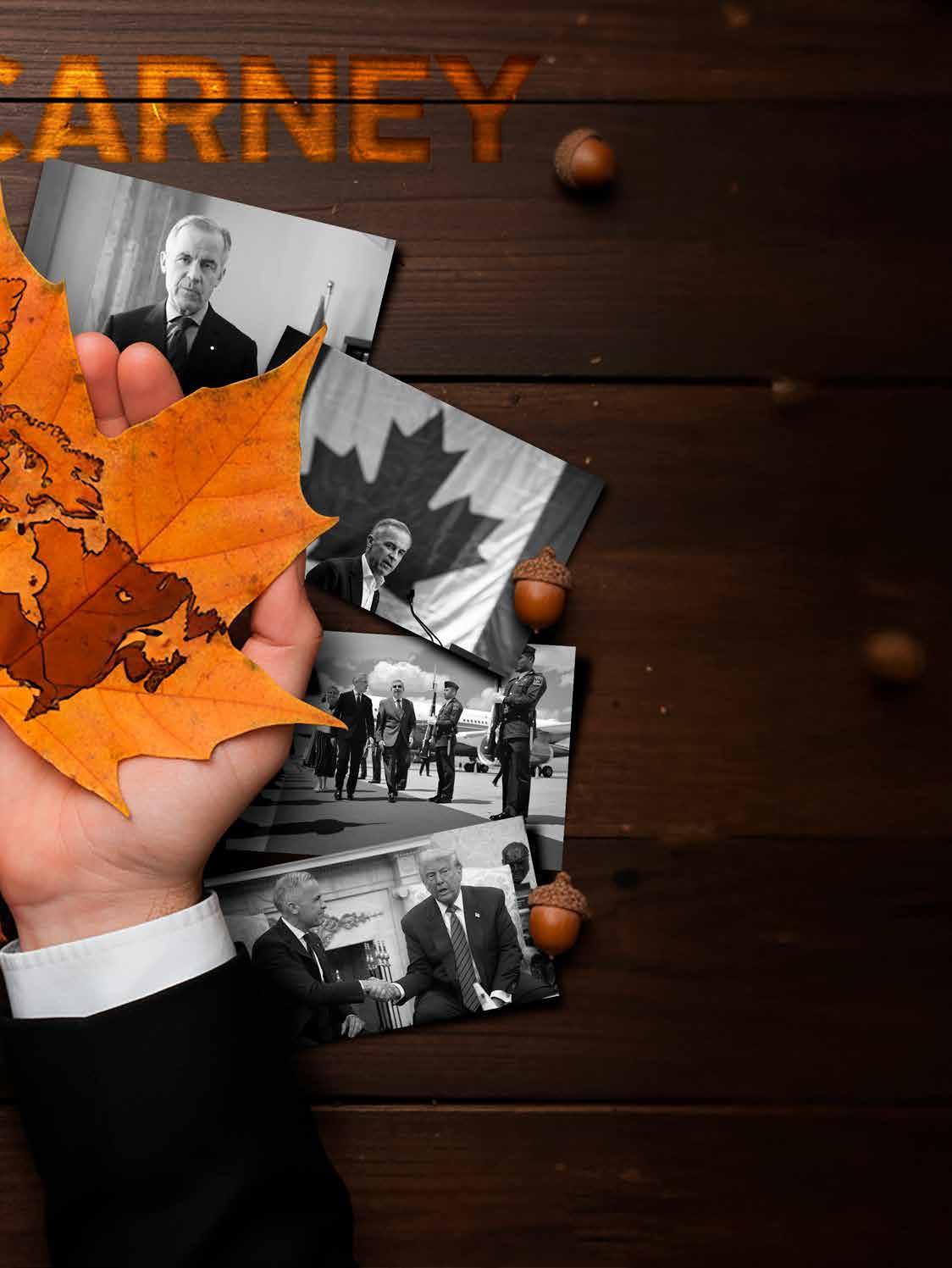
Bank of England, has boosted his credibility.
His 33-minute Oval Office meeting with Trump marked a turning point in U.S. relations.
pressure.

Canada’s 2025 federal elections took place amid renewed tensions with the U.S. during Donald Trump’s second term. Mark Carney’s victory signaled a defense of sovereignty and a move toward diversified alliances beyond Washington.
BY: ROBERTO ZEPEDA
ARTWORK: ARTURO RAMÍREZ
Canada’s federal elections in April 2025 marked a crucial moment in the country’s political landscape — not just because of the Liberal Party’s win under Mark Carney’s leadership, but also due to the challenging geopolitical environment driven by rising political and economic tensions with the United States. The tariff threats and rhetorical provocations from U.S. President Donald Trump significantly influenced the election’s outcome, prompting many voters to more strongly defend Canadian sovereignty.
HISTORICAL TIES
The peaceful relationship between Canada and the United States has lasted for over two centuries. However, this changed significantly after Donald Trump returned to the U.S. presidency in 2024. His “Make America Great Again” (MAGA) policies—especially regarding trade and security—caused tensions that directly affected Canada’s 2025 federal elections.
Canada’s political system has deep roots in its colonial past. Originally a British colony (1763–1867), it became a self-governing dominion in 1867 through the British North America Act, now called the Constitution Act. The country adopted a Westminster-style parliamentary system that combines a constitutional monarchy with democratic government. Parliament includes the Crown (represented by the Governor General), the Executive (led by the Prime Minister and Cabinet), and a bicameral legislature made up of the House of Commons and the Senate. Despite its large size, Canada’s population is mostly concentrated near the U.S. border, especially along the Quebec–Windsor corridor. This proximity has historically shaped the country’s economic policies.
POLITICAL TRANSITIONS
OCCURRING EVERY DECADE
Since the 1980s, Canadian federal politics have experienced cyclical shifts in power between Conservative and Liberal governments, with each party usually controlling for about a decade. This pattern started with Brian
03
Rising tensions with the U.S shaped Canada’s 2025 vote. 01 Carney’s victory signaled a move to protect Canada’s sovereignty. 02 Trump’s rhetoric amplified nationalist feelings throughout Canada.
Mulroney’s Progressive Conservative government (1984–1993), followed by Jean Chrétien’s Liberal administrations (1993–2003) and Paul Martin’s (2004–2006). The Conservatives returned under Stephen Harper’s majority (2006–2015), then the Liberals under Justin Trudeau (2015–2025). These alternating cycles between the two main parties reflect an electorate that favors change after long periods of one-party rule, while also emphasizing the stability of Canada’s parliamentary democracy.
A CHANGE IN U.S.–CANADA RELATIONS
For over two centuries, Canada and the United States have maintained a mostly peaceful bilateral relationship, supported by strong economic ties, shared democratic values, and broad security cooperation. However, Donald J. Trump’s return to the U.S. presidency in 2025 marked a turning point in that historic relationship. Recalling the unilateral tone of his previous administration, Trump reintroduced aggressive protectionist policies, rhetorical provocations, and open challenges to Canadian sovereignty.
UNUSUAL ELECTIONS
The 2025 elections took place amid geopolitical and economic tensions and rising internal polarization. Mark Carney—an experienced technocrat in global financial governance— assumed leadership of the Liberal Party after Prime Minister Justin Trudeau’s resignation. Within days of his appointment, Carney called for early elections to secure a mandate to confront what he described as a “U.S. betrayal” of Canadian sovereignty. The election resulted in a narrow win for the Liberal Party, which secured 169 seats—just three short of an outright majority—against a revitalized but ultimately unsuccessful Conservative opposition led by Pierre Poilievre. The vote was marked not only by close margins in several districts but also by the collapse of the New Democratic Party (NDP) and the regional strength of the Bloc Québécois. A key factor in the results was the growing perception of the need for political stability in response to external threats—driven by strategic progressive voting and the high media visibility of the “Trump factor.”
THE TRUMP EFFECT
CANADA’S 2025 FEDERAL
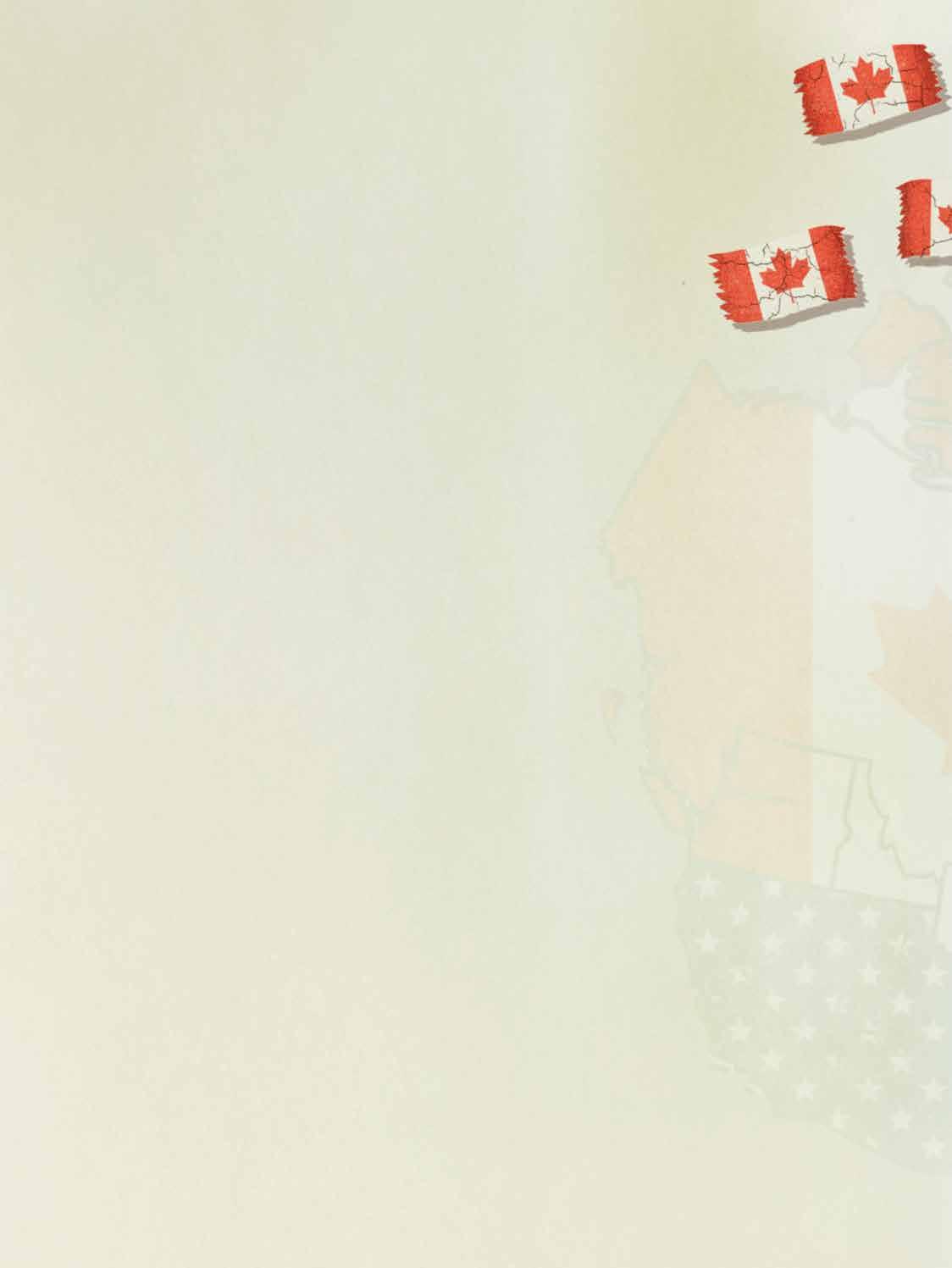
MONDAY / 11 / 17 / 2025
169
seats: Liberals’ slim victory in the 2025 election.
2
centuries: The length of U.S.–Canada peaceful ties.
3 07
seats short: How close Liberals were to a majority.
2025 ELECTIONS TRUMP EFFECT

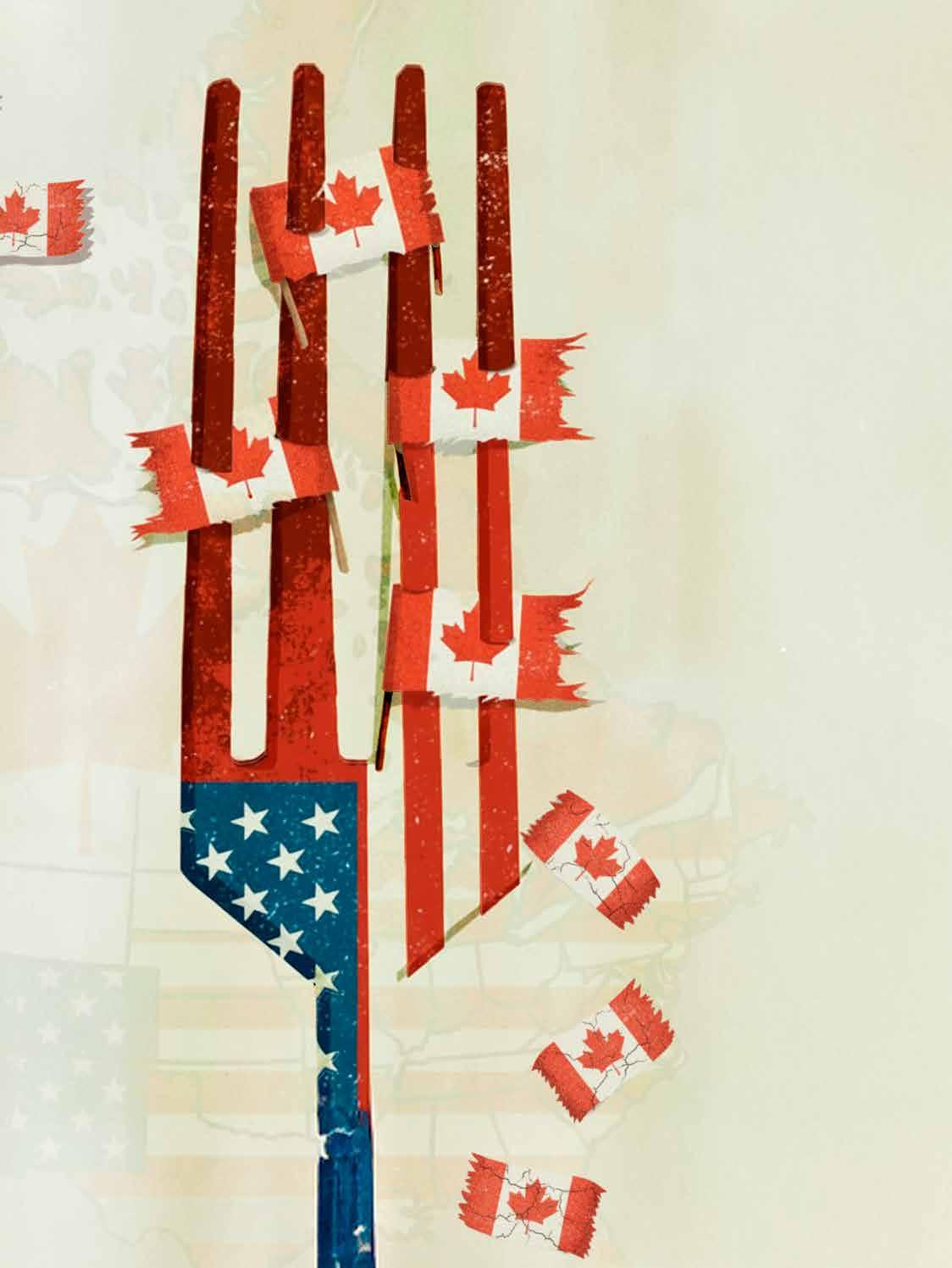
MARK CARNEY’S LEADERSHIP
Prime Minister Carney’s government outlined a vision focused on reducing Canada’s economic reliance on the United States and strengthening relationships with Europe, Asia, and Latin America. Canadian trade patterns began to mirror this strategic shift, with increasingly diverse exports responding to U.S. tariffs.
Carney capitalized on widespread discontent over symbolic annexation threats—Trump even suggested that Canada become the 51st U.S. state—and built his legitimacy around defending Canada’s resources, territory, and political autonomy. This strategy resonated strongly with voters, many of whom boycotted American products and services during the campaign.
WHO IS MARK CARNEY?
Mark Carney is a Canadian politician and economist, former central banker, and the country’s 24th prime minister. He is also the leader of the Liberal Party and a Member of Parliament for Nepean—positions he assumed in the same year.
Born in Fort Smith, Northwest Territories, and raised in Edmonton, Alberta, Carney studied English literature and mathematics at Harvard University before earning a master’s and a D.Phil. in Economics from Oxford University.
He began his professional career in the private sector, working for Goldman Sachs in London, Tokyo, and New York, where he gained experience in international finance and risk management. In 2003, he joined the Bank of Canada as deputy governor and was appointed governor in 2008, guiding Canada through the global financial crisis with relatively mild impacts.
In 2013, he became the first non-British person to serve as governor of the Bank of England since its founding in 1694, a role he held until 2020. He managed the monetary aspects of Brexit and maintained financial stability.
Later, Carney concentrated on the link between finance and climate change. In 2020, he was named the UN Special Envoy for Climate Action and Finance, guiding the creation of the Glasgow Financial Alliance for Net Zero (GFANZ), launched at the COP26 climate summit. He also took part in global economic forums such as the World Economic Forum and the Group of Thirty (G30).
In 2024, Carney was appointed as a special adviser to the Liberal Party’s Economic Growth Task Force, actively participating in the Trudeau government’s economic policies during the COVID-19 pandemic.
His shift from technocratic leadership in central banking to electoral politics reflects a modern trend where expertise in global finance, climate policy, and multilateral coordination has become more vital for national leadership. His political career continues to evolve amid complex challenges in economic management, geopolitical shifts, and climate resilience.


Economic exchange between Mexico and Canada is no longer limited to goods and services. Creative industries, education, and knowledge diplomacy have become key components of a bilateral relationship that combines culture, innovation, and strategy.
BY: GRACIELA MARTÍNEZ-ZALCE* ARTWORK: IVAN BARRERA
For decades, Mexico-Canada relations were measured by trade data—exports, investments, treaties, and balance sheets. But the twenty-first century has brought an unexpected new element: the creative economy and academic diplomacy as key drivers of bilateral progress. Knowledge, ideas, and cultural expressions are now just as valuable as manufactured goods.
In the 1990s, Canada enhanced its public diplomacy through programs that connected education, culture, and international outreach. Initiatives like the Faculty Research Programme and the Faculty Enrichment Programme, part of the Understanding Canada umbrella, provided research grants, academic exchanges, and teaching support. These efforts fostered networks between Canadian and foreign universities—including UNAM—in a climate influenced by the enthusiasm generated by the North American Free Trade Agreement (NAFTA).
In Mexico, that momentum coincided with a growing interest in mutual understanding. Conferences, publications, and artistic residencies laid the groundwork for a more sophisticated form of cooperation, leading to the creation of the Mexican Association for Canadian Studies (AMEC) in 1992 and, a few years later, the establishment of the Mexican Journal of Canadian Studies. This “golden age” of academic diplomacy demonstrated that culture and research can also generate economic and lasting benefits.
CULTURE THAT DRIVES GROWTH
The most notable change happened in 2018, when the Canadian government launched the Creative Export Strategy, a policy designed to boost the international profile of its cultural industries. The initiative acknowledged the economic significance of the creative sector—responsible for 2.7% of Canada’s Gross Domestic Product (GDP)—and allocated over 100 million Canadian dollars (CAD) to support 500 companies across the audiovisual, publishing, music, performing arts, visual, and digital sectors.
The strategy not only boosted creative industries as a source of employment but also positioned them as a tool of economic diplomacy. By integrating culture into its foreign policy, Canada combined the protection of cultural diversity with a clear commercial vision. Some of these investments resulted in trade missions, participation in international fairs, and the opening of strategic markets— including Mexico City, a key hub in Latin America.
Canada demonstrates that culture and education can lead diplomacy, while Mexico needs to rebuild support to unlock its creative potential on a global scale.
MEXICO: CONTRAST AND CHALLENGE
During the same period, Mexico experienced a decline in its international promotion policies. The dissolution of PROMÉXICO in 2018 represented a setback in efforts to boost cultural and creative exports. Without a strategy like Canada’s, Mexican industries—such as film, design, music, visual arts, gastronomy, and fashion—were left without an official partner to enhance their global presence.
This asymmetry uncovers a structural imbalance: while Canada has transformed culture into an economic and diplomatic asset, Mexico still treats it as a symbolic complement. However, Mexico’s creative potential is immense. Reinstating policies that promote the international movement of art, design, and cultural innovation would not only generate income but also elevate Mexican identity as a global asset.
ACADEMIC MOBILITY: COOPERATION OR PART OF THE EDUCATIONAL MARKET?
In a tense North American landscape, culture and knowledge might provide the most lasting way to achieve meaningful Mexico–Canada cooperation.
Another aspect of economic diplomacy lies in the academic sector. Due to decreased public funding, several Canadian universities have adopted direct promotion strategies. The CALDO consortium, consisting of five research institutions, organizes international missions to foster exchanges and joint programs. EduCanada, on the other hand, hosts annual fairs in Mexico to promote study opportunities and language courses. These initiatives are valuable but raise an important question: what kind of relationship develops when education is viewed as a exportable service? If academic mobility is reduced to student recruitment, cooperation risks turning into a transaction. Conversely, when critical thinking and joint knowledge creation are prioritized, education becomes a form of longterm diplomacy that builds trust and mutual understanding.
CULTURE, ECONOMY, AND FOREIGN POLICY
* RESEARCHER AT THE CENTER FOR RESEARCH ON NORTH AMERICA (CISAN–UNAM)
MEXICO–CANADA RELATIONSHIP ECONOMY DIPLOMACY

Canada’s experience shows that investing in culture also promotes development. Its creative export plan and ongoing support for academic networks demonstrate a future-oriented approach—one of diplomacy that encourages innovation, inclusion, and global competitiveness. For Mexico, the challenge is rebuilding that support infrastructure. Viewing culture and education not as costs but as strategic investments could help rebalance the bilateral relationship and unlock the potential of a shared ecosystem. In a North American context marked by political and economic tensions, culture and knowledge may be the most lasting keys to cooperation.
TRADE AND INVESTMENT
430,000 MEXICANS

56
BILLION CAD IN BILATERAL TRADE OF GOODS (2024).
With over 80 years of diplomatic ties, Mexico and Canada foster a vibrant relationship that crosses borders; work, education, tourism, trade, and investment support a growing alliance across North America.
2.6 MILLION CANADIANS TRAVELED TO MEXICO IN 2024, MAKING IT THE SECOND-LARGEST SOURCE OF TOURISTS.

CANADA: MEXICO IS THE THIRD-LARGEST TRADING PARTNER.
BEYOND BORDERS
MEXICO: CANADA’S THIRD-LARGEST TRADING PARTNER AFTER THE U.S. AND CHINA.
MEXICO & CANADA PARTNERS
BY: OSO OSEGUERA ARTWORK: ARTURO RAMÍREZ


O$46.4
BILLION CAD IN CANADIAN DIRECT INVESTMENT IN MEXICO (AS OF 2024).
ver the past eighty years, Mexico and Canada have grown from distant partners into a strategic alliance seen in classrooms, farms, beaches, and trade deals. Both countries share a cooperative vision based on prosperity, mobility, inclusion, security, and sustainability under the Canada–Mexico Action Plan 2025–2028.
Mexico and Canada strengthened their alliance through mobility, academic exchange, and a record 2.6 million Canadian visitors in 2024.

One of the key pillars of this relationship is the exchange of people. In 2024, over 2.6 million Canadians traveled to Mexico, while 430,000 Mexicans visited Canada. Thousands of Canadian retirees also spend part of the year living in Mexico. Conversely, Canada welcomed more than 52,000 Mexican workers through temporary labor programs, including 26,000 under the Seasonal Agricultural Workers Program (SAWP)— considered an international model for labor mobility.
Academic and cultural collaboration continues to grow. In 2023, Canada issued over 11,000 study permits to Mexican students, an 80% jump over five years, while more than 14,000 took short-term language courses. Currently, there are over 300 agreements between higher education institutions in both countries, making Mexico the top Latin American source of international students in Canada.
Bilateral trade reached CAD $56 billion, and Mexico is now Canada’s ninth-largest investment destination, with over CAD $46.4 billion.

MEXICO RANKS AS THE NINTH-LARGEST DESTINATION WORLDWIDE FOR CANADIAN INVESTMENT.
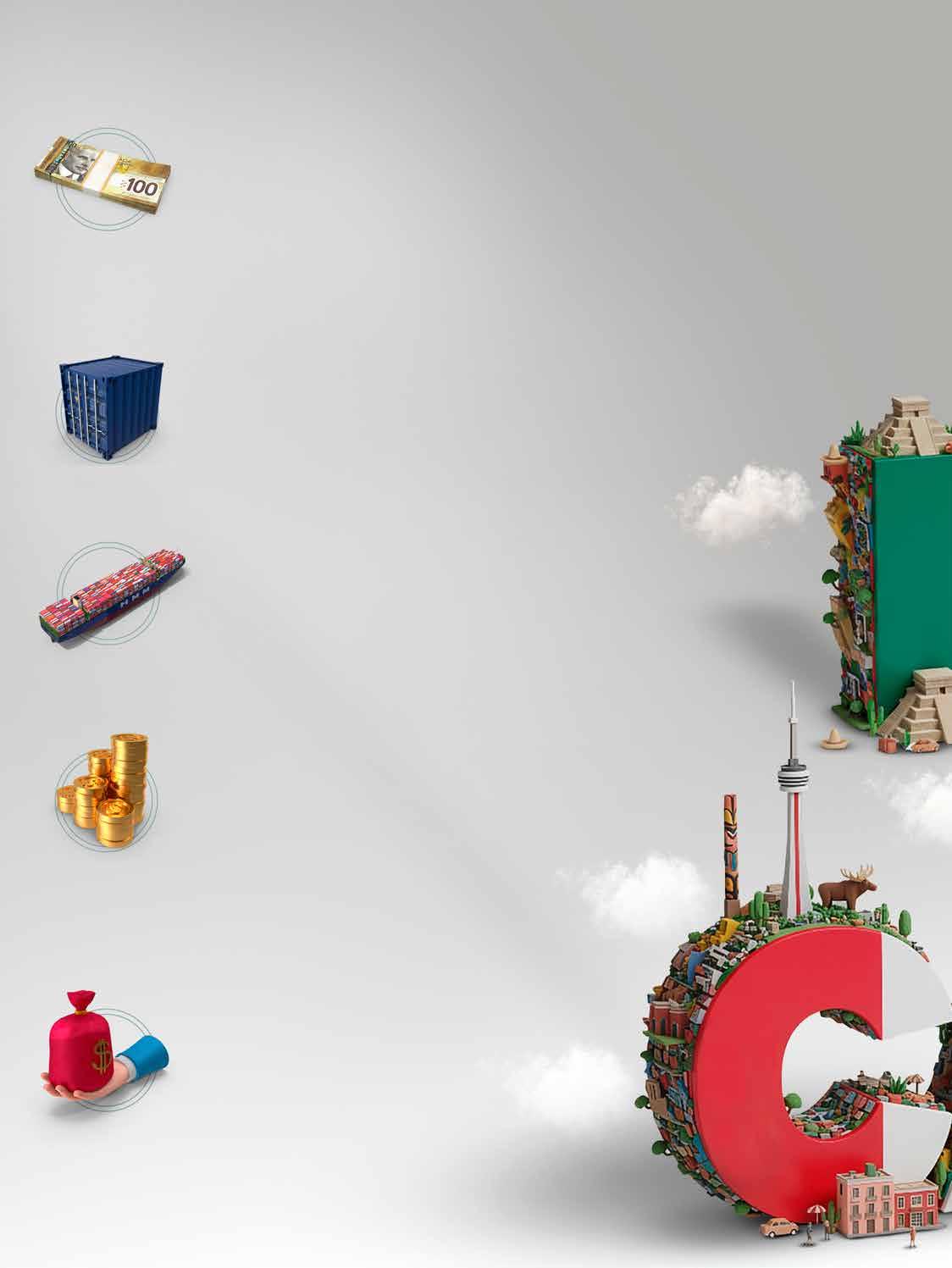
Economically, the relationship remains strong. Bilateral trade in goods reached $56 billion CAD in 2024, while Canadian direct investment in Mexico exceeded $46.4 billion CAD, making Mexico Canada’s ninth-largest destination for foreign investment. Since 2000, Export Development Canada (EDC) has operated in Mexico, promoting exports, energy, mining, and infrastructure. Along with the United States, both countries continue to strengthen cooperation through the USMCA and the North American Leaders’ Summit.






50,000 CANADIAN RETIREES LIVE IN MEXICO PART OF THE YEAR.
52,000 MEXICAN WORKERS ARRIVED IN CANADA IN 2024.

26,000 PEOPLE PARTICIPATED IN THE SEASONAL AGRICULTURAL WORKERS PROGRAM (SAWP).

MEXICO CONTINUES TO BE THE LEADING SOURCE COUNTRY FOR CANADA’S AGRICULTURAL LABOR PROGRAM.

11,000 STUDY PERMITS ISSUED TO MEXICANS IN 2023 (+80% OVER FIVE YEARS).


14,000 MEXICANS ENROLLED IN SHORT-TERM LANGUAGE COURSES.

OVER 300 ACADEMIC AGREEMENTS BETWEEN MEXICAN AND CANADIAN UNIVERSITIES.
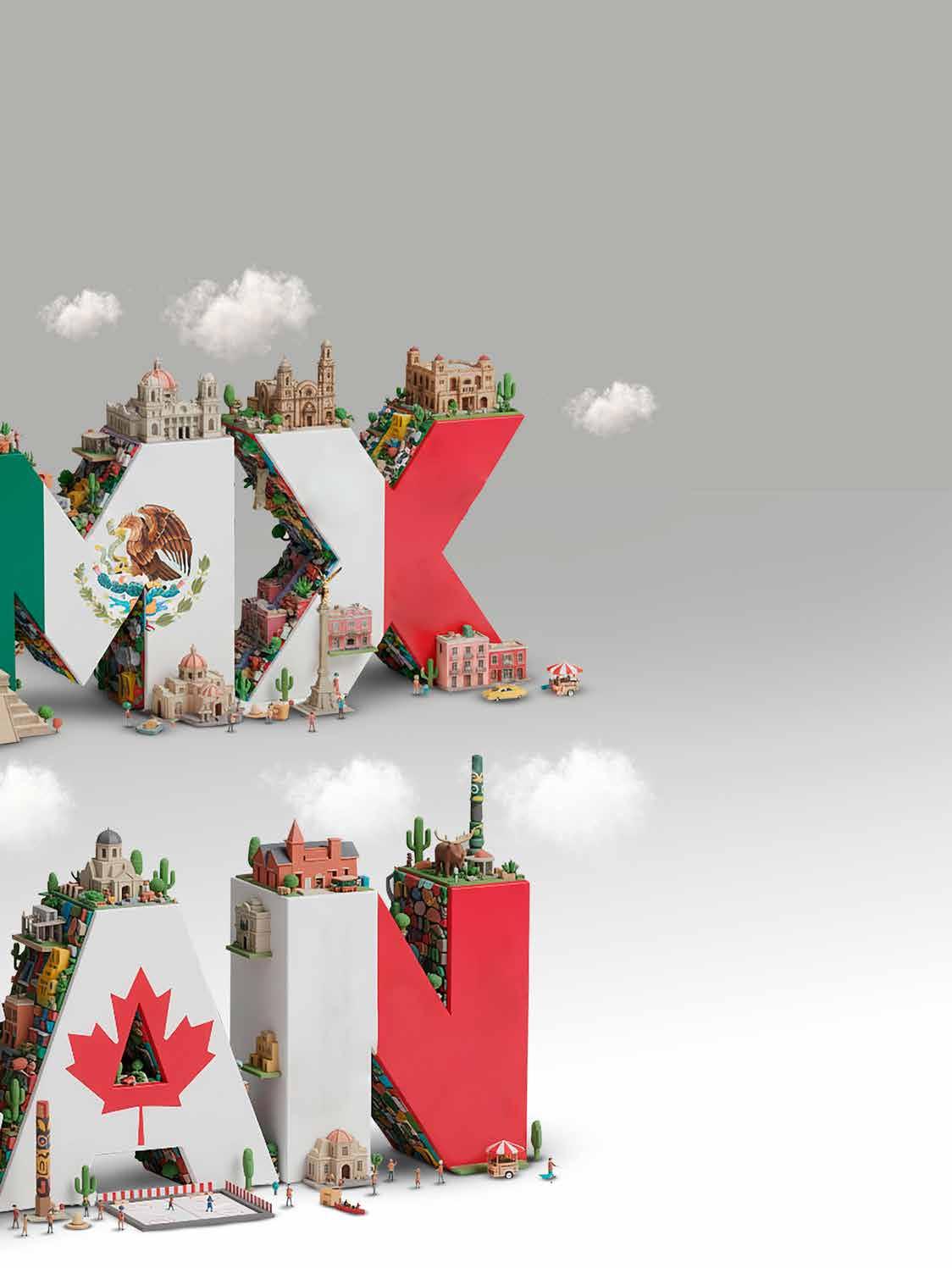
01

It took Guillermo del Toro 50 years to bring to the screen the emotions and reflections that Frankenstein awakened in him when he was just 11 years old in Guadalajara.
Frankenstein is the thirteenth feature film in Guillermo del Toro’s filmography, although the themes it explores have shaped his career for more than three decades, starting with Cronos (1992). 02
Guillermo del Toro has been nominated for six Academy Awards and has won three throughout his career. Frankenstein received a 13-minute standing ovation at the Venice Film Festival.
Seven years ago, I met Guillermo del Toro at the Morelia International Film Festival. He was presenting The Shape of Water, the film that would go on to win multiple Academy Awards.
Frankenstein the Creature That Took Guillermo del Toro
HALF A CENTURY TO BUILD
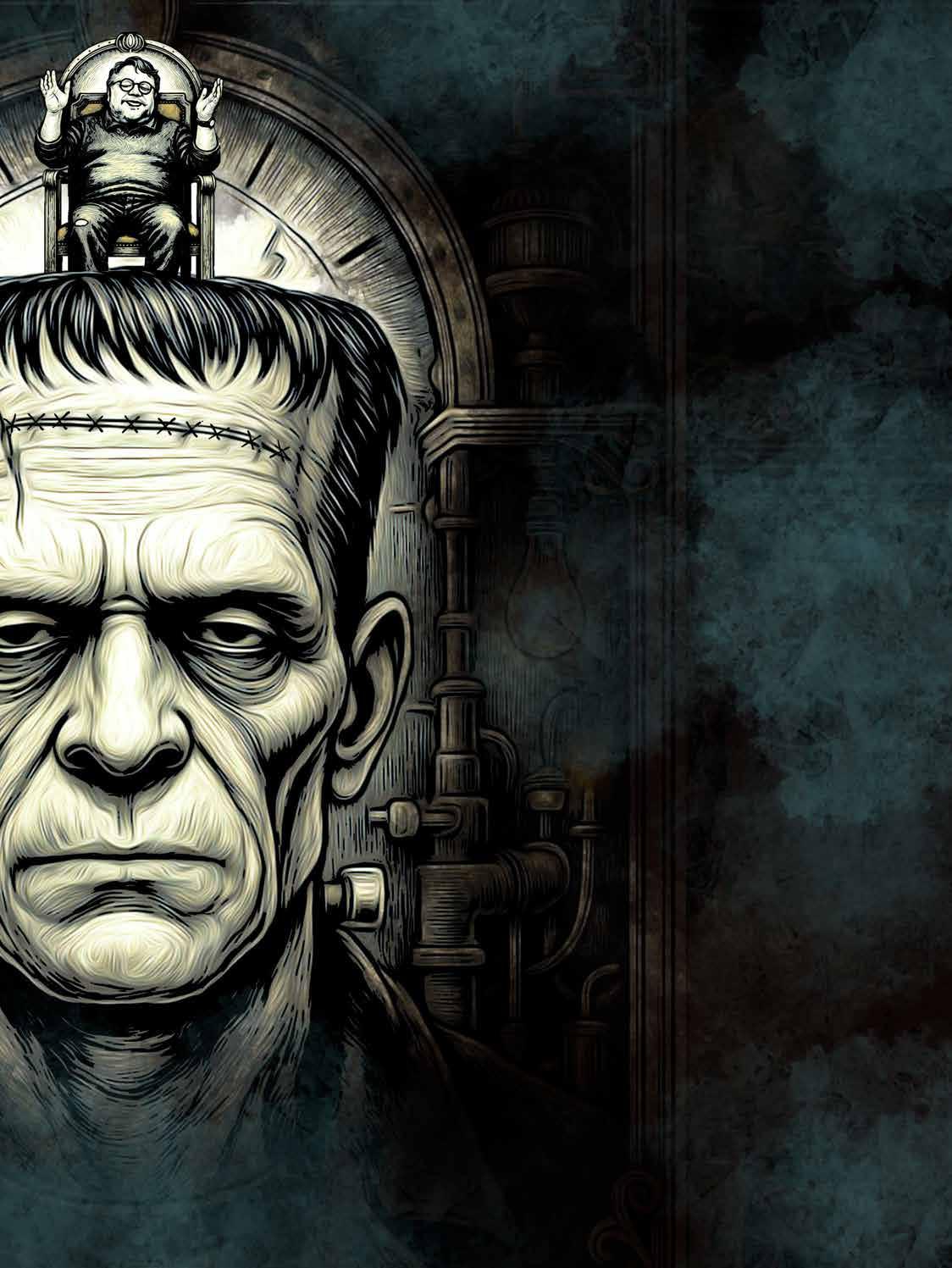
BY: GONZALO LIRA GALVÁN ART: IVAN BARRERA
During that conversation, Del Toro mentioned something that at the time seemed merely anecdotal. He recounted his first encounter with Boris Karloff’s Frankenstein, referring to the creature as something beautiful—something that inspired him to create his own “Monster Club” in a small room when he was eleven years old.
Not even ten years have passed since that conversation, but fifty years have gone by since the story he told. And it is precisely that half-century that it took for that young boy from Guadalajara to bring to the world his own version of the story that moved and marked him so deeply at such an early age.
Heraldo: Hello, Guillermo. You’ve spoken about Frankenstein as a project that’s been circling in your mind since childhood, but also as a kind of biographical exercise about Mary Shelley herself.
How much of a woman’s perspective from 200 years ago do you bring into your own vision? And how do you keep your perspective within hers?
GDT: You fuse your identity with whatever it is you want to create. Think about it— when a song is renewed by another singer or a different arrangement, it changes its weight, right? I was born to sing a song, and this is it, however you want to call it. It’s composed in equal parts by Ismael Rodríguez and Mary Shelley, by my own biography, the Romantic movement, and who knows what other fragments formed this monster. You know what I mean?
To me, films like La oveja negra or No desearás la mujer de tu hijo are just as important as Shelley’s novel.
My duty is just one thing: to capture the spirit of the novel—to give it the spirit of creation, which is what I’ve wanted to express for fifty years—and to renew the audience’s emotional bond with the story. If I adapt the novel timidly, then I’m giving you something classic, pastel-colored, and predictable.
But if I open with the creature nearly destroying an entire ship, the first thing you’ll think is: “I’ve never seen this version of the creature before—why is it so violent?” And the answer at the end is, “Ah, I get it now, that’s why it was so violent. I understand where that pain came from.”
You renew the audience’s connection with the story. Those who know the novel say, “I understand why he did it—it works.”
And if you don’t like it, well, the novel is still there. You can buy it at your local bookstore. But this comes from a place of love. I say that adapting a book is like marrying a widow—you have to respect the memory of the husband, but on Saturday night you still have to “make it your own.”
Heraldo: In the prologue to one of the many editions of Frankenstein, you wrote that “all art is a self-portrait, and all storytelling is autobiography.” You also said that “the true north of life is death.” How do you connect these ideas in the film?
GDT: Because they’re true. Look, I’ve written five prologues for different editions of Frankenstein, and honestly, in all of them I had no idea that one day I would actually make the movie—it seemed impossible.
For me, the beauty of the book is that it’s Mary Shelley’s autobiography. There are so many elements that, if you know her life, you can clearly see. And the same goes for the film. In the movie, I also wanted to fill in biographical gaps that haven’t really been explored. The image of
the father as a villain, for instance—that’s not in Shelley’s Frankenstein, but it appears in her other work.
Shelley wrote a novel called Matilda that’s brutal, and in her last two novels, there are tyrannical father figures. The idea of war, for example, is what frames her within the Romantic movement. So when I write prologues for these books, I try to shed light on the way I see the text— the same way I did when translating it into film.
My statement that “the true north of life is death” comes from Romanticism. Romanticism is founded on the recognition of death and love—how they coexist, how birth and death can also merge. It’s a movement that’s deeply violent, iconoclastic, anarchic. It sought to destroy what its poets, musicians, and painters saw as a hypocritical society. It’s an intensely passionate, youthful movement.
People forget that Mary Shelley was 16 years old when she met Percy Shelley. He was 21 and already married. They decided to run away together, against all family opposition.
He brought her poison—laudanum, a tincture of opium—and told her, “Drink this poison, and I’ll shoot myself in the head. We’ll live together eternally, since they won’t let us be.” And he arrived with the pistol loaded.
Romanticism, to me, is like the English becoming Mexican—embracing melodrama wholeheartedly. And it’s no coincidence that much of the Gothic Romantic movement happened in warm countries like Italy and Spain. You see what I mean? There’s a kind of Latin passion there. That’s why I think Mexican melodrama is unleashed Romanticism, you know? “Hit me, kill me, but don’t leave me.” Damn.
Heraldo: Since childhood, you’ve had the desire to do something with Frankenstein. What does it mean to do it now, considering where you are professionally, personally, and artistically?
GDT: I don’t know how it happened, but the fact that this movie fulfills the dream of an eleven-year-old kid from a small Mexican town, who rode his bike to a supermarket called Maxi, bought a pocket-sized edition of Frankenstein, and said, “I’m going to make this movie”—wow. It happened at 61 years old, and I have no idea how. The odds were astronomical, and it almost didn’t happen. It’s a film I actively developed for over twenty years, and everyone said no. The same thing happened with Pinocchio.
To me, the biography of humanity is the biography of broken families. All great movements, as Shakespearean tragedy and historical analysis show, stem from the absence of affection in early childhood. The Napoleonic wars, political corruption—all of it comes from the absence of figures that complete the self in childhood.
My films always speak of childhood and horror. They speak of children—like in Blade II, which is the story of a vampiric son returning to question his father: “Why did you create me like this? Why did you throw me into the world this way?”
That’s Frankenstein. The same as the little girl in Cronos or the children in Pan’s Labyrinth and The Devil’s Backbone. I made another story about a boy this time—one created by another wounded child trying to heal his own past, but who ends up reproducing the same brutality. It’s not a metaphor—our lives are the metaphor.
You tell yourself, “I won’t repeat the mistakes I saw my father make,” and suddenly, at forty-one, you say, “Wait— when did I become my dad?” It’s powerful stuff.
SAÚL CRUZ
A MIGRANT WHO PAINTS WHAT HIS PEOPLE LIVE
In a conversation with Saúl, a young artist currently living in Northern California (Stockton), we learn about a story rooted in the culture of hard work that shaped his childhood in Culiacán, Sinaloa. Today, his paintings are featured in #NoKings protests against ICE.
BY: ALAN VARGAS
PHOTOART:IVAN BARRERA
Since he was a child, Saúl displayed a strong passion for drawing — even winning school contests for his pencil sketches — but the need to work kept him away from art for more than 20 years. As he told Heraldo USA:
SAÚL: “It wasn’t until 2019, during the COVID-19 pandemic, that the lockdown reconnected me with my calling. I had a notebook and a pencil; I started drawing so I wouldn’t go crazy. That moment of introspection marked a before and after — from then on, I became a full-time artist.”
“I PAINT THE SOUL”
That’s how he describes his work. His paintings depict deep emotions, migrant stories, and scenes that show both the suffering and dignity of the Mexican people.
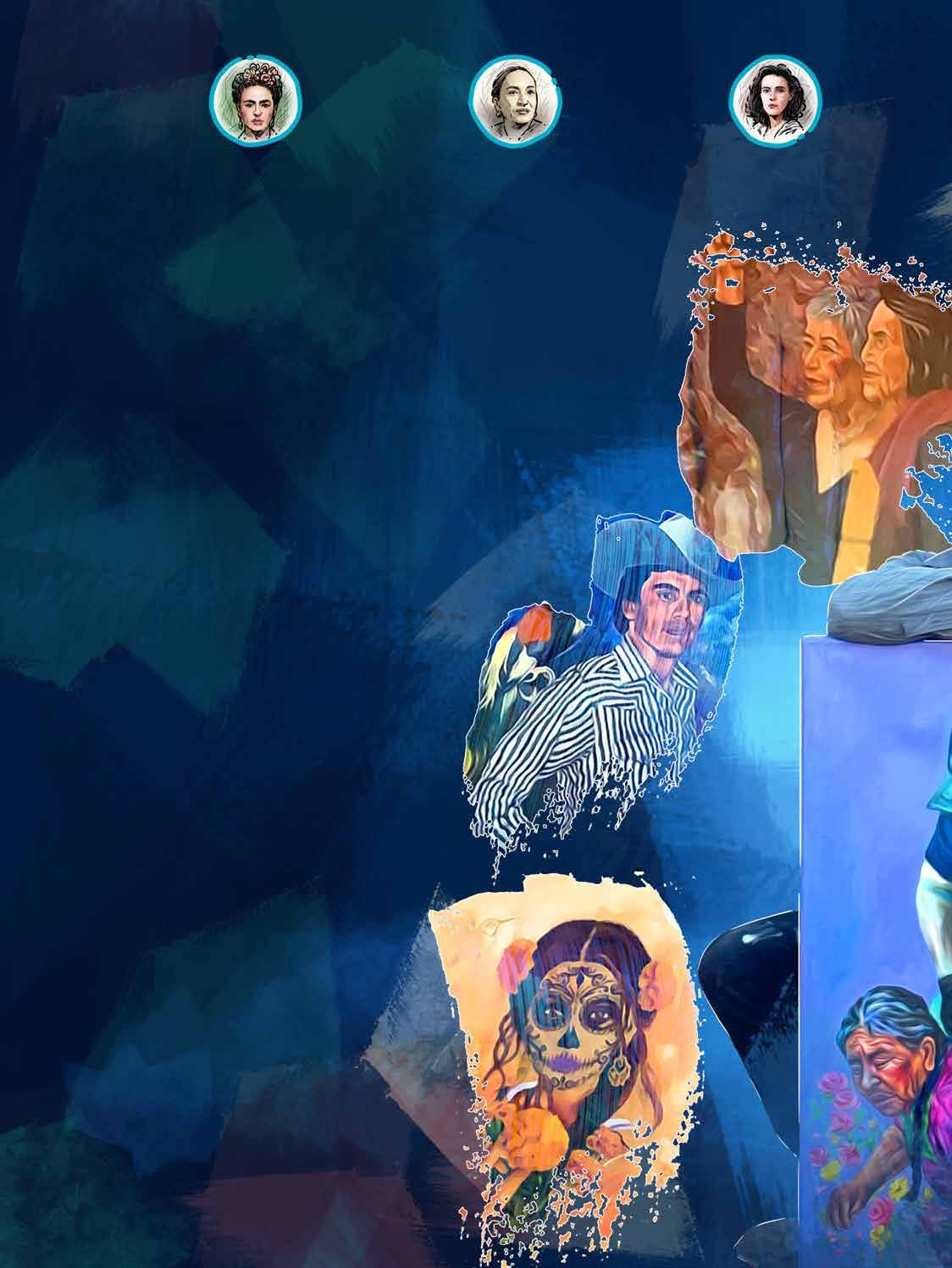
Saúl took a break from art until the 2019 lockdown rekindled the passion he had since childhood.
2
1 versions: Astronaut José Hernández asked Saúl for a second copy of the portrait that moved him deeply.
1
message: “Don’t live in fear. Study, know your history, and walk with purpose,” Saúl tells migrants in the U.S.

SAÚL: “It’s not political art; it’s historical art. I paint what’s happening to us — to our people.”
Among his most recognized works is a painting of an Indigenous woman being arrested by an ICE agent named “López.” The image went viral on social media and appeared on protest banners during anti-deportation marches across the U.S.
SAÚL: “That image haunted me; I dreamed about it several times until one day I painted it. It was a reaction from the soul. The piece connected deeply with the community. I received hundreds of messages from people who felt represented. Many said they cried when they saw it; others felt anger, but all of them were deeply affected by it. That was my greatest reward.”
He says: “We are the most oppressed people — and also the strongest. Painting our history is my way of resisting.”
“WE ARE NOT IGNORANT”
Another notable piece shows astronaut José Hernández holding a Mexican flag and the moon in his hands.
SAÚL: “Many people think that because we work in the fields, we’re ignorant. That’s not true. There’s great wisdom in those who come from hard work.”
“I met José Hernández in person, and the painting moved him. He even asked me for a second version to keep. Hernández is a humble man — he represents the best of us,” Saúl recalls.
His presence has grown on social media, where his community supports and shares each new piece.
SAÚL: “I paint from the soul. I don’t just want to portray faces but moments that shape history. In my paintings, I blend realism with symbolism: Indigenous women with flowers, field workers surrounded by color, migrants with wings or chains — figures that embody the duality of life at the border. For me, every stroke is a conversation between nostalgia and hope.”
“I haven’t been able to go back home, but my art keeps me connected to it every day.”
Here’s the message he sends to Mexicans living in the U.S.: “To my fellow Mexicans in the U.S., I send a message of strength: Don’t be afraid. Living in fear means constantly looking over your shoulder. Be cautious, but don’t live in fear. Study, learn your history, and find yourself. As long as you do good, even if bad things happen, you’ll keep walking with purpose.”
IF I HAVE MY LIFE AND HEALTH, I’LL KEEP PAINTING”
That’s how Saúl concludes the conversation. His story reflects that of thousands of migrants who, through hard work, continue to build a nation often called the world’s greatest power — though it couldn’t exist without the effort of those who cross borders. In his own words: Destiny guides us by the hand. I just want to leave my mark on a canvas so that someday someone will look at my painting and say, ‘That was painted by Saúl Cruz.’ painting: His image of an Indigenous woman being arrested by ICE went viral and became a symbol in migrant protests.
LILIA CARRILLO (1930–1974)

